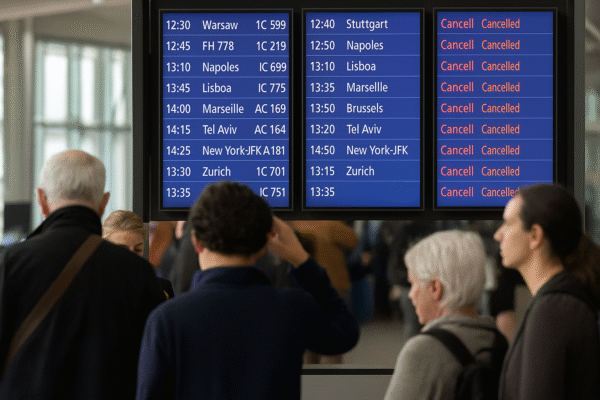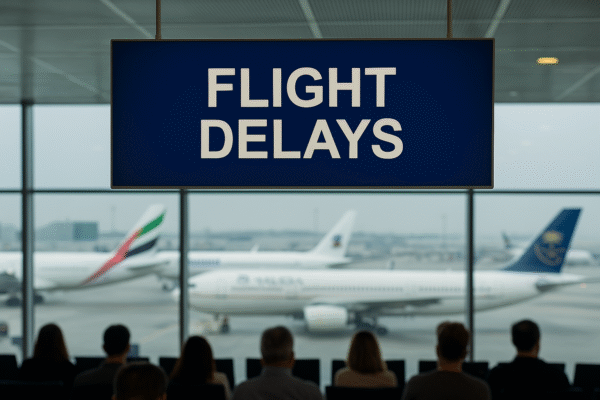Dubai, Jeddah & Riyadh— Travel across the Middle East has hit a snag today as major airports—including Dubai International (DXB), King Abdulaziz International (JED) in Jeddah, King Fahd International (DMM) in Dammam, and King Khalid International (RUH) in Riyadh—have reported significant flight delays and cancellations. Operational hiccups, air traffic congestion, and other logistical challenges have significantly impacted airlines such as Emirates, FlyDubai, and Saudia, causing widespread disruption for travelers.
According to Travel and Tour World, Dubai International saw 68 delays and 2 cancellations, with FlyDubai suffering 20 delays (5% of its operations) and Emirates 24 delays (4%). At Jeddah’s King Abdulaziz Airport, 38 flights were delayed and 7 cancelled, hitting Saudia especially hard with 21 delays and 7 cancellations. At Dammam’s King Fahd Airport, there were 8 delays and 5 cancellations, while Riyadh’s King Khalid Airport reported 31 delays and 2 cancellations, mostly affecting Saudia flights.
Causes of the Disruptions
These disruptions come amid a confluence of operational constraints. Airports in the region face increasing air traffic volume, and constraints in airspace management are amplifying delays. Broader regional tensions and ongoing Middle East airspace instability are adding further strain on schedules and capacity.
Additionally, conflicts in nearby areas continue to complicate travel. Disruptions in Gulf airspace have been reported previously, leading to temporary rerouting or additional buffer time for flights. Despite a status update indicating a “very low” delay index at Dubai International Airport, the scale of delays suggests underlying system stress.
Impact on Airlines and Travelers
- Emirates & FlyDubai: Long-haul and regional routes are experiencing considerable delays, especially for flights to South Asia, Europe, and Africa.
- Saudia: Particularly affected across three Saudi airports, pointing to systemic delays.
- Other carriers like IndiGo, Qatar Airways, and Air India Express are among those facing intermittent disruptions as well.
For tourists and business travelers, these disruptions mean missed connections, itinerary uncertainty, and extended airport time. Many are scrambling to rebook flights or secure accommodations, particularly during the busy travel season.
Traveler Advisory
If your flight departs from DXB, JED, DMM, or RUH today, here’s how to prepare:
- Check Flight Status Frequently
Use airline apps or airport websites for real-time updates. - Use Flexible Rebooking Options
Carriers like Emirates and Saudia often waive fees during operational disruptions. - Locate Alternate Flights
Look into other regional carriers or routes through less congested airports. - Expect Longer Wait Times
Arrive early and anticipate delays at check-in and security. - Know Your Rights
Holidaymakers flying within the EU or from EU-based airlines may be eligible for compensation or assistance, depending on the cause of disruption.
Regulatory Outlook and Industry Response
These disruptions underscore the need for improved resilience in regional air traffic infrastructure and airspace management. The International Air Transport Association (IATA) and Eurocontrol have stressed the importance of investing in digital ATC systems and strengthening airspace coordination—both of which are essential for reducing delays globally.
Meanwhile, despite a 13% increase in first-half 2025 passenger traffic through Abu Dhabi’s airports, it’s clear that even high-capacity hubs like Zayed International must prepare for broader regional volatility to sustain growth.
Summary Table
| Airport | Delays | Cancellations | Main Airlines Affected |
|---|---|---|---|
| Dubai (DXB) | 68 | 2 | Emirates, FlyDubai, IndiGo |
| Jeddah (JED) | 38 | 7 | Saudia, FlyDubai, IndiGo |
| Dammam (DMM) | 8 | 5 | Saudia, FlyDubai |
| Riyadh (RUH) | 31 | 2 | Saudia, Flynas, others |
Conclusion
Today’s widespread disruptions at Dubai, Jeddah, and Riyadh airports highlight the vulnerabilities of a highly connected Middle Eastern aviation network. With operational challenges intensified by regional instability, travelers — and the tourism industry — must brace for continued volatility. Staying vigilant, flexible, and informed is now as essential as booking your flight.
For more travel news like this, keep reading Global Travel Wire

















